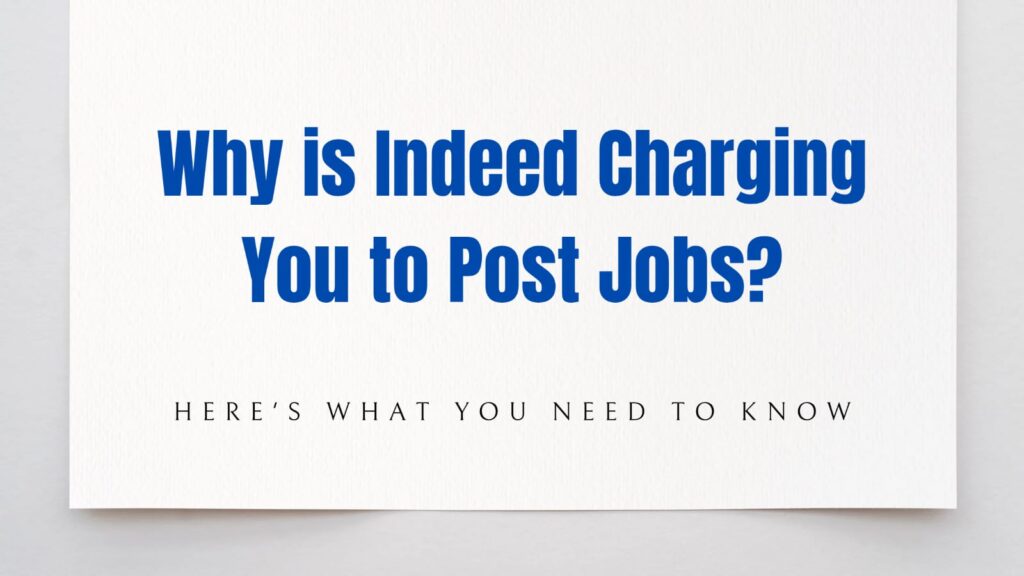
Why Indeed Charging?
Table of Contents
When hiring managers and employers turn to job boards like Indeed, the expectation is often straightforward: find qualified candidates quickly and efficiently. However, many employers are surprised to discover that posting a job on Indeed can come with a price tag. Why does Indeed charging for job postings, and is it worth the cost? Let’s break down the details Indeed Charging to give you a clear understanding of how this works and how you can optimize your recruitment efforts on Indeed.
1. What Is Indeed?
Indeed is one of the largest and most popular online job boards in the world. It connects millions of job seekers with employers across various industries, providing a platform where candidates can search for opportunities and companies can advertise their openings. While Indeed offers some free services, many of its features, including job postings, come with costs designed to enhance visibility and attract qualified applicants.
2. Does Indeed Charging for All Job Postings?
The short answer is: not always. Indeed allows employers to post jobs for free, but there are specific conditions and limitations. Free job postings typically receive less visibility because they compete with paid listings. Paid postings, on the other hand, are often “sponsored” and prioritized, making them more likely to appear at the top of search results.
3. Why Does Indeed Charging for Certain Job Postings?
Indeed charges employers for job postings as part of its pay-per-click (PPC) model. This means that employers pay when a candidate clicks on their job listing. Here are some reasons behind this pricing structure:
3.1 Enhanced Visibility
Paid job postings are promoted to ensure they reach a larger audience. This increases the chances of finding suitable candidates quickly, which is particularly important for urgent hiring needs.
3.2 Competition Among Employers
With millions of jobs posted on Indeed, free listings can easily get lost in the crowd. Paid sponsorship ensures your job posting stands out among competitors.
3.3 Targeted Reach
When you pay for a job posting, Indeed allows you to target specific demographics, locations, and industries. This targeted approach ensures you’re reaching the most relevant candidates, saving you time and resources.
4. Understanding Indeed’s Pay-Per-Click Model
Indeed’s pricing operates on a pay-per-click basis, meaning you’re only charged when someone interacts with your job ad. Here’s how it works:
- Set Your Budget: Employers can set a daily or total budget for their job postings.
- Cost Per Click (CPC): The amount you pay per click varies based on factors such as the job title, location, and competition within your industry.
- Flexibility: You have control over your spending, and you can pause or stop your ad at any time.
5. Free vs. Paid Job Postings on Indeed
It’s essential to understand the difference between free and paid job postings to determine which option aligns with your hiring goals.
5.1 Free Job Postings
- Appear lower in search results.
- Limited reach and visibility.
- Ideal for roles with low competition or a surplus of candidates.
5.2 Paid Job Postings
- Sponsored jobs appear at the top of search results.
- Targeted to specific audiences for better quality applications.
- More effective for urgent or specialized hiring needs.
6. How Much Does Indeed Charging to Post a Job on Indeed?
The cost of posting a job on Indeed varies widely based on several factors:
- Industry and Job Type: Specialized roles often have higher costs due to increased competition.
- Location: Costs may differ based on the geographical area and local job market.
- Budget Settings: You control how much you’re willing to spend per day or per campaign.
Typically, employers can expect to pay anywhere from $0.10 to $5 per click, with daily budgets ranging from $10 to $500 or more.
7. Benefits of Paid Job Postings on Indeed
Investing in paid job postings can offer significant advantages:
7.1 Faster Results
Sponsored jobs are more likely to attract candidates quickly, reducing time-to-hire.
7.2 Better Quality Applicants
Targeted visibility ensures your job ad reaches candidates with the right qualifications and experience.
7.3 Customizable Campaigns
With control over your budget and ad settings, you can tailor your approach to suit your hiring needs.
8. Tips to Maximize ROI on Indeed
To get the most out of your paid job postings, consider these strategies:
8.1 Craft a Compelling Job Ad
Use clear, concise, and engaging language. Highlight key responsibilities, qualifications, and benefits to attract the best candidates.
8.2 Optimize Keywords
Incorporate relevant keywords to improve searchability. For example, include specific job titles, skills, and locations.
8.3 Set a Realistic Budget
Choose a budget that aligns with your hiring goals. Start small and adjust as needed based on performance metrics.
8.4 Leverage Analytics
Monitor the performance of your job postings using Indeed’s analytics tools. This will help you identify what’s working and make necessary adjustments.
9. Alternatives to Indeed
While Indeed is a powerful platform, it’s worth exploring other job boards and recruitment methods to diversify your approach. Options include:
- LinkedIn: Ideal for professional networking and niche roles.
- Glassdoor: Great for employer branding and candidate reviews.
- ZipRecruiter: Known for its AI-driven candidate matching.
10. Conclusion
So, why is Indeed charging you to post a job? The answer lies in its commitment to delivering value through enhanced visibility, targeted reach, and faster results. While free postings may suffice for some roles, indeed charging job ads can significantly improve your chances of finding the right candidates efficiently. By understanding Indeed’s pricing model and leveraging its features strategically, you can make the most of your recruitment efforts and achieve your hiring goals.
Hello